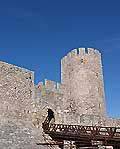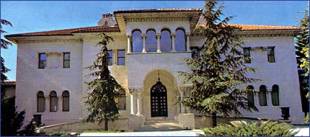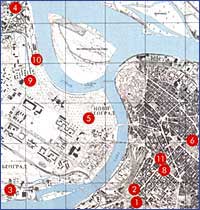
| History of Belgrade |
Belgrade - old white town
 Belgrade, a city of very tumultuous history, is one of the oldest cities in Europe. Its history lasts full 7,000 years. The area around two great rivers, the Sava and the Danube has been inhabited as early as palaeolithic period. Remains of human bones and skulls of Neanderthals, found in the stone-pit near Lestane, in a cave in Cukarica and near the Bajloni market, date back to the early Stone Age.
Belgrade, a city of very tumultuous history, is one of the oldest cities in Europe. Its history lasts full 7,000 years. The area around two great rivers, the Sava and the Danube has been inhabited as early as palaeolithic period. Remains of human bones and skulls of Neanderthals, found in the stone-pit near Lestane, in a cave in Cukarica and near the Bajloni market, date back to the early Stone Age.
Remains of the late Stone Age culture have been found in Vinča, Zarkovo and in Upper Town, above the Sava and Dunav confluence. It indicates that the area of Belgrade has been continually inhabited and that the intensity of the settling has been getting higher and higher. Many of today's settlements in Belgrade surroundings lie on cultural layers of earlier prehistoric settlements.
 Vinča near Belgrade comes among the most important settlements and cultural sites of the prehistoric period. The presence of Illyrians is characteristic for the Bronze Age. The archaeological excavations at Rospi Cuprija, Upper Town, Karaburma, Zemun and Vinca confirm hypotheses that the Belgrade area has been intensively inhabited and that its population has been engaged in plough agriculture and other supporting economic activities. Necropolises of the Bronze and Metal Ages as well as the evidence of different cultural influences have been discovered at these locations.
Vinča near Belgrade comes among the most important settlements and cultural sites of the prehistoric period. The presence of Illyrians is characteristic for the Bronze Age. The archaeological excavations at Rospi Cuprija, Upper Town, Karaburma, Zemun and Vinca confirm hypotheses that the Belgrade area has been intensively inhabited and that its population has been engaged in plough agriculture and other supporting economic activities. Necropolises of the Bronze and Metal Ages as well as the evidence of different cultural influences have been discovered at these locations.
In c. 600 B.C. the Thracian-Cimmerian and Scythian tribes moved across this area, while the Celtic tribes crossed this territory in the III century B.C. The founding of Singidunum is attributed to the Celtic tribe, the Scordiscs. As a fortified settlement, Singidunum was mentioned for the first time in 279 B.C. The first part of the word - Singi - means "round" and dunum means "fortress" or "town". It is possible that the name originated from the name of the Thracian tribe, the Sings, which was settled on this area when the Celts came. There are almost no traces about that Celtic town, except the necropolises found at the Karaburma and Rospi Ćuprija locations. These contained valuable artistic artefacts, that belong to the warriors of the Scordiscan tribe. A considerable Celtic cultural influences have been woven into the spiritual culture of the Singidunum inhabitants, and later mixed with Roman classical cultural elements.
 The disintegration of the Roman Empire was followed by invasion of barbarian peoples: Eastern Goths, Gepidaes, Sarmatians, Avars, Slavs and others. Because of its advanced position at the border - limes, Belgrade suffered frequent attacks and destructions. The attacks coming from the north, across Pannonia, the Danube and Sava, were so hard that even Singidunum, an important military stronghold, could not resist them. The Huns captured it and completely destroyed it in 441. Singidunum lost its Roman inhabitants then. After the fall of the Huns, the town became a part of the Byzantine Empire once again in 454, but it was soon conquered by the Sarmatians, and later the Eastern Goths. However, already in 488, it became a Byzantine town again.
The disintegration of the Roman Empire was followed by invasion of barbarian peoples: Eastern Goths, Gepidaes, Sarmatians, Avars, Slavs and others. Because of its advanced position at the border - limes, Belgrade suffered frequent attacks and destructions. The attacks coming from the north, across Pannonia, the Danube and Sava, were so hard that even Singidunum, an important military stronghold, could not resist them. The Huns captured it and completely destroyed it in 441. Singidunum lost its Roman inhabitants then. After the fall of the Huns, the town became a part of the Byzantine Empire once again in 454, but it was soon conquered by the Sarmatians, and later the Eastern Goths. However, already in 488, it became a Byzantine town again.
The Serbian rule over Belgrade began in 1284, when the Serbian king Dragutin, son-in-law and vassal of the Hungarian king Ladislav IV was given rule over Mačva and Belgrade. It was a period of intensive settling of Serbian population and increasing influence of the Serbian Orthodox Church. Dragutin's court was in Belgrade. Newly built Cathedral was a symbol of power and wealth of the young Serbian state. After Dragutin's death, his brother Milutin came to the throne, but he has ruled over Belgrade for a short time, for in 1319 it was captured and totally destroyed by the Hungarians. Demolished and abandoned town became a border foothold of Hungarian resistance to expansion of the Serbian state from the south, in the time of Czar Dušan. In that condition Belgrade enters the XV century, when the Turks, a new conquering force, appeared on the historical stage of Europe.
 The Turks knew that Belgrade was the greatest obstacle in their campaigns towards Central Europe. After the fall of Smederevo in 1440 the Belgrade fortress was under siege by the Turkish army with over 100,000 soldiers, led by Sultan Murad II. Having a strong desire to conquer the town, the Turks have built Žrnov, a stronghold on the Avala hill. From there they were able to observe and control the surrounding area. For almost a century Belgrade has resisted Turkish attacks. Finally, under the command of Sultan Suleiman the Magnificent, on August 28, 1521, the Turks managed to conquer Belgrade - the rampart of Christianity and the key of defence of whole Hungary. The town was demolished and burnt down, and the way to Western Europe open.
The Turks knew that Belgrade was the greatest obstacle in their campaigns towards Central Europe. After the fall of Smederevo in 1440 the Belgrade fortress was under siege by the Turkish army with over 100,000 soldiers, led by Sultan Murad II. Having a strong desire to conquer the town, the Turks have built Žrnov, a stronghold on the Avala hill. From there they were able to observe and control the surrounding area. For almost a century Belgrade has resisted Turkish attacks. Finally, under the command of Sultan Suleiman the Magnificent, on August 28, 1521, the Turks managed to conquer Belgrade - the rampart of Christianity and the key of defence of whole Hungary. The town was demolished and burnt down, and the way to Western Europe open.
Awakening of national consciousness and events related to the slaughter of the knezes led to organization of the First Serbian Insurrection in 1804. The insurrection led by Karađorđe from the very beginning was also aimed at liberation of Belgrade. After two years of fight, the town was conquered on January 8, 1806. Around 25,000 Serbian insurrectionists led by Karađorđe Petrović found the town in ruins. It became the capital of recently liberated part of Serbia and a symbol of freedom-loving tradition of its population. After renewal it also became an important economic, trade and cultural center. Already in 1807, the Praviteljstvujušči Sovjet (Serbian government) had its meeting in Belgrade, and in 1811 the first ministries were established there. The persons of high reputation and intellectuals move to Belgrade from Vojvodina and other regions. Among them were Sima Milutinović and Dositej Obradović, who in 1808 founded the first Great School.
 The intensive development of Belgrade which started after its final liberation from the Turks continued in the first years of the XX century. The construction of the railway station and river port on the Sava moved the gravitational center of the city and former Turkish-Oriental area known as Dorćol began to lose its former importance. However, the further development of the city was hindered by a fact that Belgrade was a border city and an obstacle to Austrian expansionistic policy against Balkan.
The intensive development of Belgrade which started after its final liberation from the Turks continued in the first years of the XX century. The construction of the railway station and river port on the Sava moved the gravitational center of the city and former Turkish-Oriental area known as Dorćol began to lose its former importance. However, the further development of the city was hindered by a fact that Belgrade was a border city and an obstacle to Austrian expansionistic policy against Balkan.
 WHITE PALACE - The construction was completed in 1936, by the design of Aleksandar Đorđević. The palace was renovated immediately after World War II. It was finally arranged and equipped for present purpose at the same time with the Old Palace (architect Bratislav Stjanović and his team). The complex of palaces, arranged as an integral space, serves for residential purposes.
WHITE PALACE - The construction was completed in 1936, by the design of Aleksandar Đorđević. The palace was renovated immediately after World War II. It was finally arranged and equipped for present purpose at the same time with the Old Palace (architect Bratislav Stjanović and his team). The complex of palaces, arranged as an integral space, serves for residential purposes.



 Online interactive web cameras in Belgrade
Online interactive web cameras in Belgrade